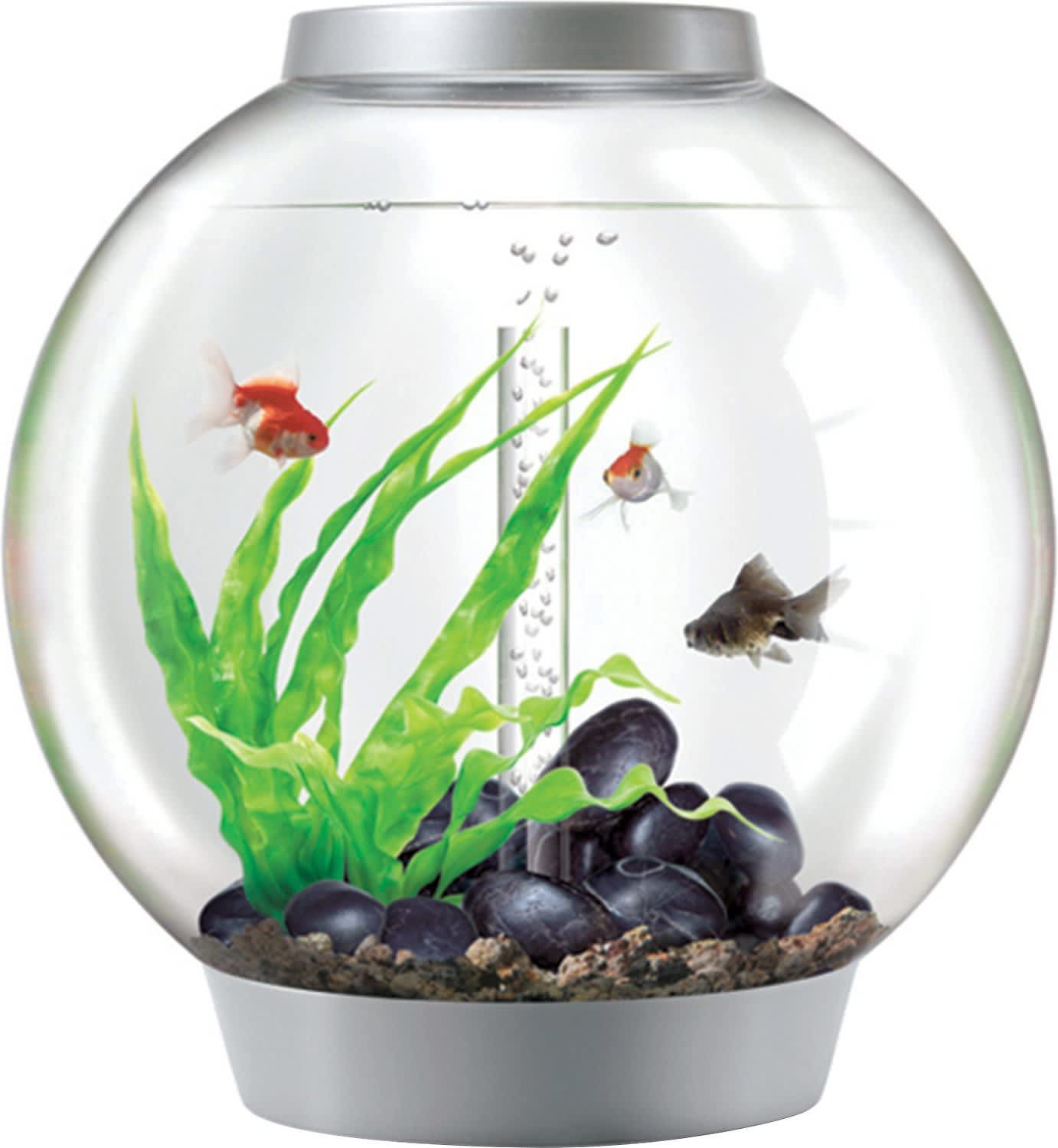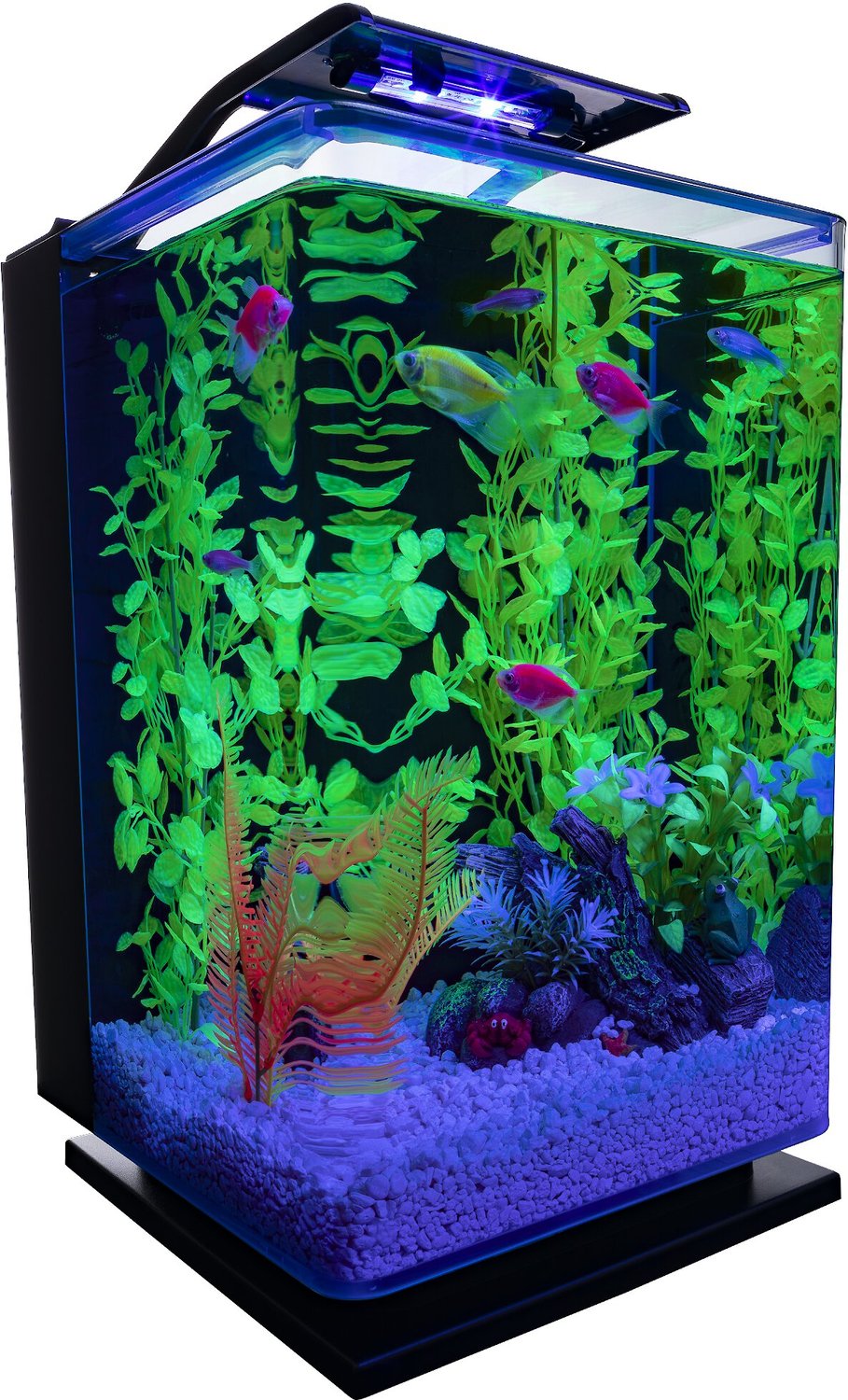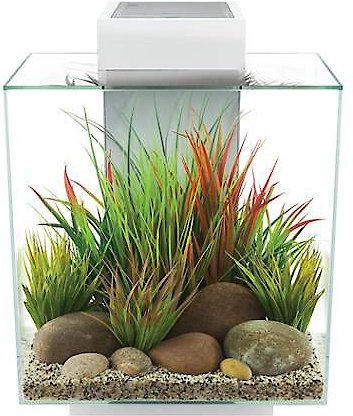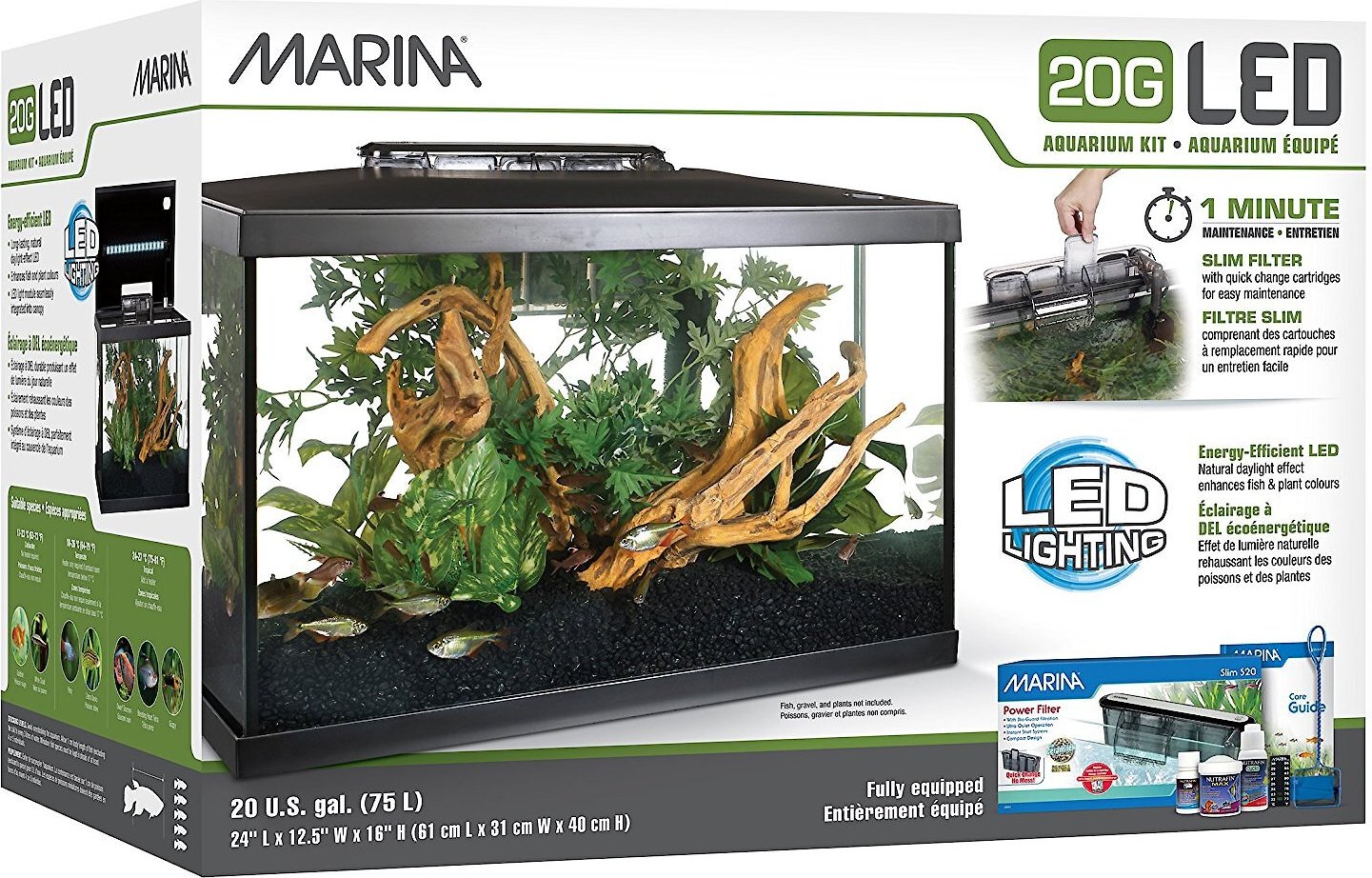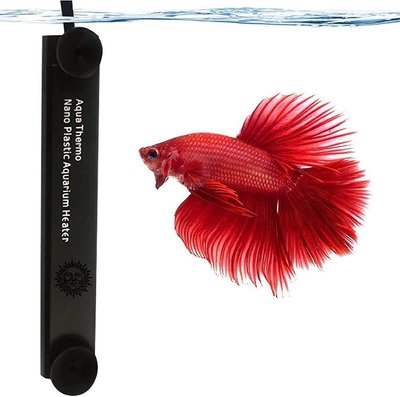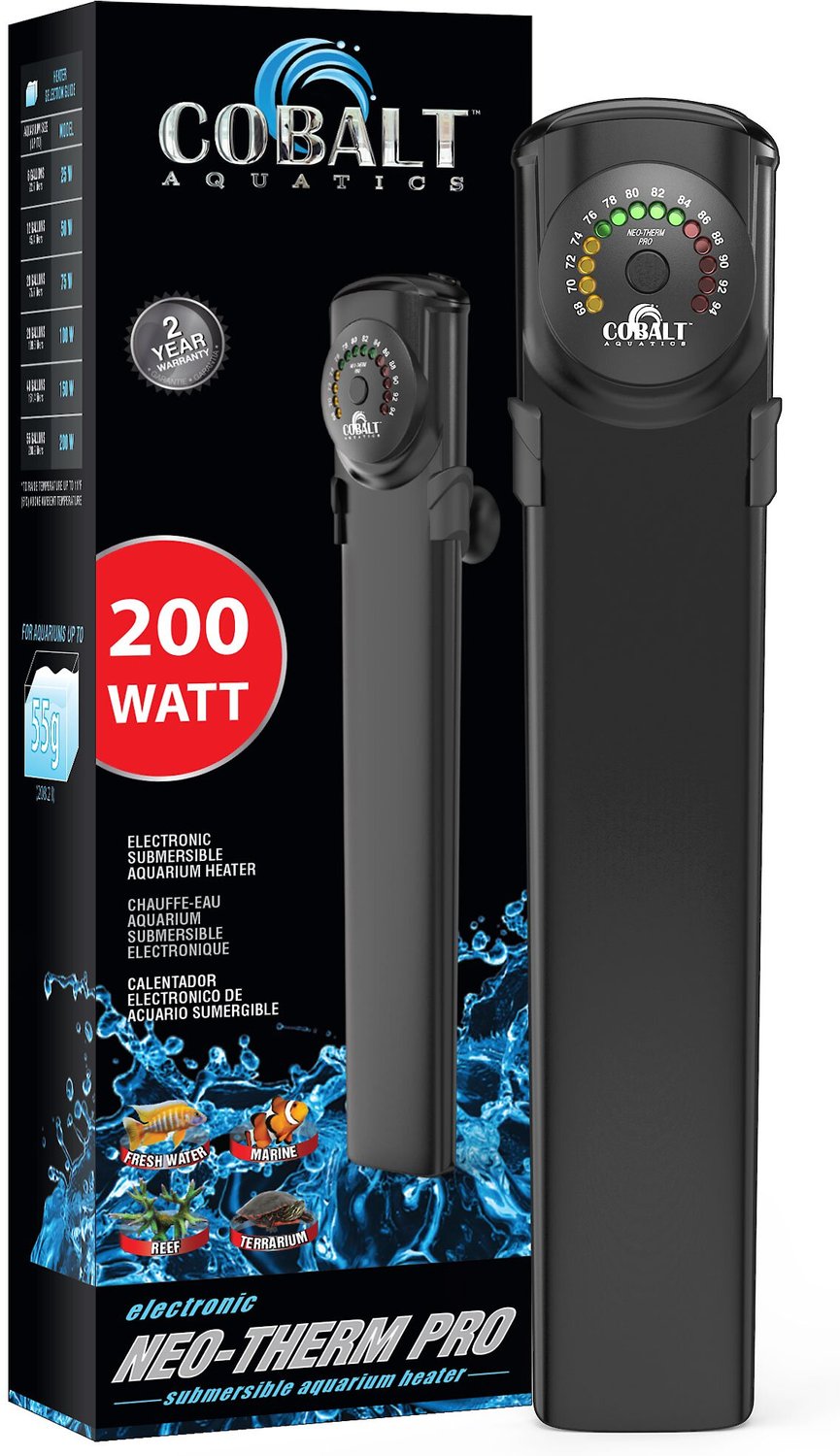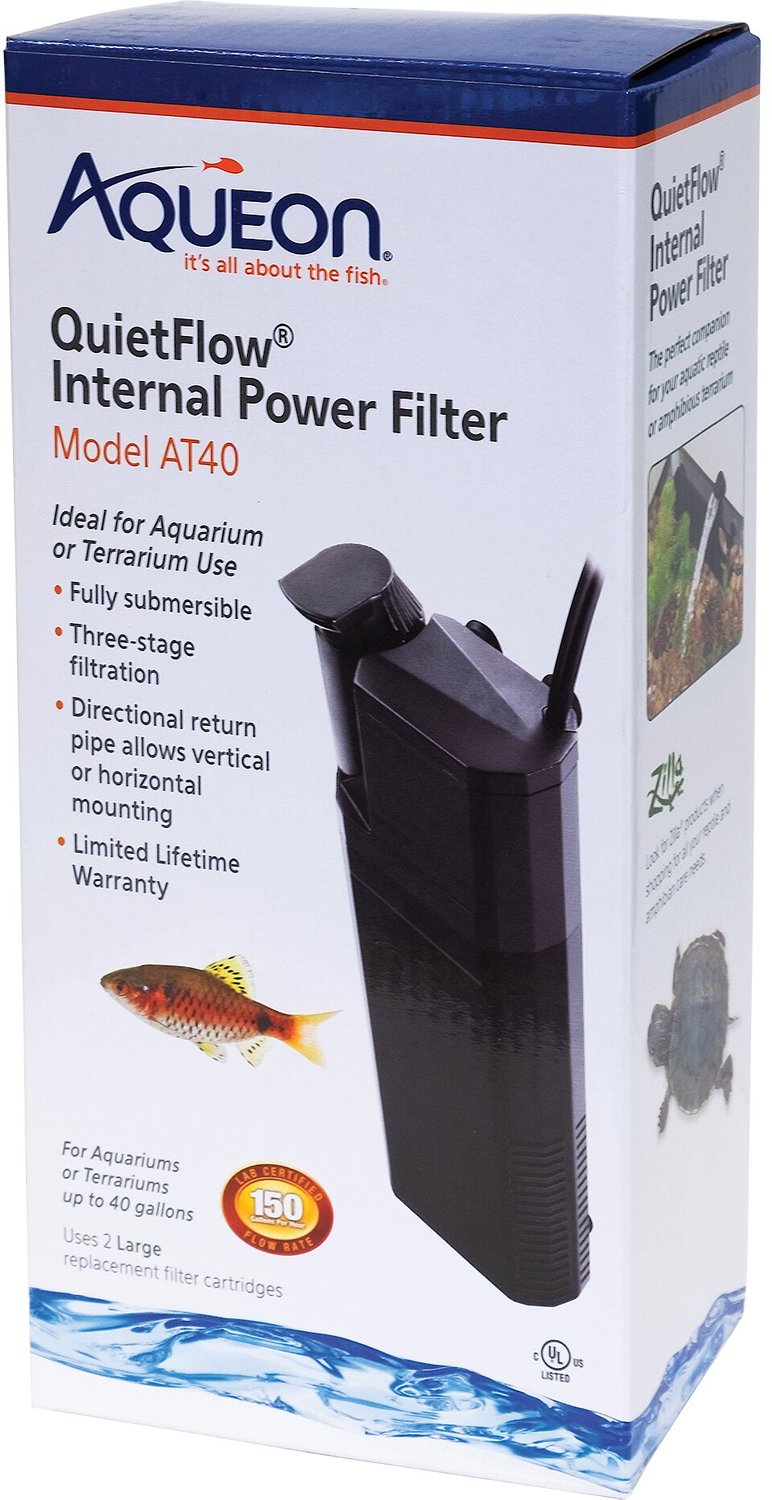Setting Up A Betta Tank (The Right Way!)
Betta fish thrive in the right environment, especially one that is spacious with natural features and places to hide. But setting up a betta tank is not always as easy as it may seem.
There are several things to consider when setting up a betta tank for the first time, such as:
- How to choose a betta tank.
- Choosing a betta tank light.
- Choosing a substrate for a betta tank.
- Adding a heater and filter to your betta tank.
- Adding water to your betta tank.
- Choosing plants and ornaments.
- And finally, add your betta to its newly set-up tank.
While learning how to set up a betta fish tank is not difficult, there are some things to keep in mind. Setting everything up correctly to start will speed up the entire process and make your first betta fish tank setup more successful.
This article will teach you, step-by-step, how to set up a betta tank, with some helpful tips to make your betta’s new environment feel like home.

Make sure to check out our Betta Fish Care Guide And Species Overview.
How To Set Up A Betta Fish Tank
I will list the steps that I use when setting up a new tank which is the same for most tanks, but there are a few differences. A betta tank is best set up using the following steps:
1. How To Choose A Betta Tank
The most important step in setting up your new betta tank is choosing the correct tank size. Betta fish are used to living in rice paddies and small, slow-moving streams, so you may think you can buy a small aquarium that doesn’t provide much space. The truth is that betta fish like plenty of space and room to move around.
A betta tank that is too small can dramatically affect your betta’s lifespan, as they may become stressed and suffer health issues in a tiny tank. Water parameters are also very difficult to maintain in smaller tanks.
You also need to decide if other fish will be joining your betta in the aquarium and, if so, what size of fish. Betta fish are not good with larger, more aggressive fish that can bully them or invade their space.
Bettas are also aggressive toward other members of their own species, hence the name Siamese Fighting Fish. If you are setting up a male and female betta tank, be aware that aggression may be a problem, so do some extra research to find the right type of tank mates.
Male bettas tend to be more aggressive than female bettas, as they defend their territory, food sources, and potential mating partners. Female bettas tend to be much more docile than male betta fish, so betta sorority tanks are a solution for more experienced aquarists.
Get A Tank With A Lid
I also recommend getting a tank with a lid as betta fish can jump quite high and may end up leaping over the rim of the tank, causing themselves an injury, or worse, they may not be found for several hours, causing them to dry up and die.
Not all betta fish jump, especially if they are settled and happy, and there are plenty of ways to reduce jumping behavior, but the best solution is to find a tank with a tight-fitting lid. Ensure the lid is high enough so your betta can still jump without hitting the top.
If your tank choice doesn’t have a lid, lower the water level a little, add plenty of plants or surface plants to restrict jumping, or consider attaching a makeshift perspex rim around the top of the tank.
Betta Tank Size
For a beginner, the ideal environment for your betta would be a 10 gallon tank. If you want some compatible tank mates and plants, choose a 20-gallon tank or larger.
The size of your betta’s tank largely depends on the number and type of other fish you are introducing. A general rule is to start with a 10 gallon tank and add 1 gallon for every inch of the expected length of a full-grown adult male’s body, although this is an absolute minimum size.
There are many all-in-one betta fish tanks for sale, often found online or at your local pet stores, but basic starter tanks are often very small.
The most common starter tank sizes are only 1 or 2 gallons. If you are just keeping a single betta fish, a small tank will probably do in the short term until you can find something bigger.
Very small tanks have potential issues, such as:
- A rapid build-up of waste, so you need to carry out frequent water changes.
- Diseases spread more quickly in smaller tanks putting your betta’s health at increased risk.
- Water temperature is less stable in a smaller tank than in a larger tank, as it is a much smaller body of water.
- Ammonia and Nitrate levels increase much quicker from uneaten food and fish waste and can be harder to keep within the correct parameters.
Larger tanks are more stable, and when issues do arise, they do so much more slowly without catching you out. Betta fish need room to move, preferring a longer, shallow aquarium over a tall narrow one.
The Fluval Spec series is quite a good option and can be found online at Amazon.com and at some other retailers.
Some recommendations are below:
BiOrb Classic 8 Gallon Led Aquarium
GloFish 5 Gallon Aquarium Kit
Coralife BioCube 32 Gallon Aquarium
Fluval Edge 12 Gallon Aquarium
Marina Led Beginner Aquarium Kit – 20 Gallon
All the aquariums above are complete kits which are the best option for beginners to set up. They should provide all of the equipment required, such as internal filters, heaters, substrates, water conditioners, and test kits.
Make sure to clean your new tank before setting it up to reduce the risk of introducing unwanted bacteria.
Where To Put A Betta Tank
As with any freshwater or saltwater fish tank, it is always wise to position the tank in areas away from windows and direct sunlight. The heat from direct sunlight can cause the water temperature to rise through the day and drop drastically at night. Direct sunlight also encourages algae growth which is best avoided.
Betta fish also prefer environments with subdued lighting, so ensure you set up your tank with this in mind. Only place your tank close to a window if the sunlight is diffused or doesn’t directly hit the tank.
Avoid positioning your betta tank in draughty areas, especially if you don’t have a heater. Cold areas can lower water temperature and make the tank uncomfortable for your betta fish. If your tank does have a heater, it will need to work much harder to maintain the correct temperature, often leading to premature failure.
2. Choosing A Betta Tank Light.
Choosing how to light your betta tank is important. Betta fish originate from environments with little natural light, but betta fish need some lighting.
The two best types of light for a betta tank are traditional fluorescent lights or the newer LED lights. Both lights are ideal for fish and plants.
LED lights offer endless variations of adjustable color temperatures, longevity, and lower power consumption. Led light strips are also good low-power options and provide many of the same benefits.
The strip light below is an excellent choice and is adjustable from 16-84 inches to fit a variety of tank sizes. This lamp uses very little power, and adjustments can be made via remote control to set the mood of your tank from your sofa.
Larger options are also available through the link below.
KZKR Aquarium LED Fish Tank Light 16-84 inch Remote Control Hood Lamp for Freshwater, Saltwater, And Marine Aquariums
Choosing a good lighting setup will help your betta’s bright, beautiful colors stand out, along with the colors of the plants and ornaments within the aquarium.
3. Choosing Betta Tank Substrate
A substrate is what covers the bottom of a fish tank. Gravel substrates are the most common, but you can also use sand, rocks, pebbles, soil, and clay to create your desired look.
Best Substrate For Bettas
Several types of substrate are suitable for a betta tank, so it ultimately depends on the look you want to achieve. Sand, gravel, and pebbles are most commonly used, but clay is found in a betta’s natural habitat, so it can also be considered.
Let’s take a quick look at the pros and cons of each.
Sand
Although not the most common substrate found in their natural habitat, sand is a good, all-around, natural-looking substrate that betta fish like.
Pros
- Sand may cloud the water when cleaned, but it settles quickly.
- Sand is soft and unlikely to damage your betta’s delicate fins.
- Sand is similar in texture to areas where some betta fish originate.
- Waste particles are easily removed from sand substrates.
Cons
- Some areas of the sand substrate can be easily dislodged when cleaning, adding water, or due to fish rubbing against it. Regular raking may be necessary.
- When cleaning with a siphon or vacuum, fine particles of sand can be easily sucked out of the tank and, over time, will need replacing.
- Plants require deeper sand for roots to take hold in comparison to heavier substrates.
Gravel
Gravel substrate is more commonly found in a bettas natural environment, and it is the easiest to maintain. When vacuuming with a gravel siphon, trapped food and waste are easy to dislodge without the risk of gravel being washed away.
Pros
- Gravel is a low-cost sturdy substrate.
- Gravel has a texture found in most natural habitats.
- Gravel is light enough that waste is easily removed through vacuuming.
- Plants can root easily in gravel.
- There are many different colors and varieties of gravel substrate to create a unique style for your tank.
Cons
- Fish often rub against gravel and rocks to scratch or remove foreign objects. Some gravel can be sharp and cause damage to delicate betta fins.
- On rare occasions, fish can actually swallow small particles of gravel that become stuck and prevent eating.

Pebbles
Pebble substrates are another good choice for betta fish. The smooth edges are gentle on bettas fins, reducing the likelihood of injury when rubbing against it. Larger gaps allow trapped waste to be easily removed when cleaned, but it’s a little trickier to move a vacuum through.
Pros
- Pebbles are found in most natural habitats that betta fish originate from.
- Pebbles tend to have smooth edges that reduce injuries to fins and scales.
- Waste sits nearer the surface and is easier to remove.
- Plants can root easily in pebble substrates.
- Pebbles come in a variety of colors and shapes.
Cons
- None to be concerned about.
Clay
Clay is probably the substrate most commonly found in a betta’s natural habitat, but it is not the easiest to clean and maintain, so it’s not widely used in betta tank setups.
Pros
- Clay is the most natural choice if you need to replicate a betta’s natural habitat.
- Plants root easily in clay substrate.
Cons
- The soft but thick texture is very difficult to clean, enabling waste and bacteria to build up.
Sand, gravel, and pebble substrates are all suitable if you want to introduce live plants, and they can be purchased in a variety of colors, sizes, and coarseness, allowing you to set up the perfect appearance for your new tank.
How To Add Substrate To Your Betta Tank
When adding substrate to your betta tank, you need to prepare it first by thoroughly washing it in a bucket of clean, soap-free warm water.
Once clean, spread the substrate evenly around the base of your aquarium. If you have chosen a gravel or pebble substrate, be careful not to crack the glass or scratch the acrylic of your tank.
Substrate Depth
The depth of the substrate depends on what type you’re adding. A sandy substrate needs to be about an inch deep, while gravel can go up to two inches. If you are adding plants, a deeper substrate will help roots to take hold.
There is no specific rule for substrate depth except that too much is hard to clean, and too little will cause gaps to continually appear, revealing the base of the tank.
4. Adding A Heater And Filter
Once you have added substrate to your betta tank, you will need a heater and a filter. Betta fish are tropical fish originating from the warm Asian climate, where they enjoy warm tropical water temperatures.
Heating A Betta Tank
An aquarium heater helps regulate the temperature of a tank due to its built-in thermostat. Heaters are an essential part of setting up a new betta tank and vary in price depending on their wattage and size.
I wrote a guide on whether betta fish need a heater that explains the reasons why and possible alternatives.
If you didn’t get a heater supplied with your tank, I have added a few options below.
SunGrow Betta Fish & Turtle Aquarium Tank Water Heater, 10-watt
A compact 10W heater, ideal for tanks up to 3.5 gallons. Completely automatic thermostat programmed to heat your tank to a consistent 75°F, perfect for betta fish. This heater is encased in toughened plastic to protect your betta from burns.
Eheim Jager Thermostat Aquarium Heater 50W
A simple, fully submersible aquarium heater with auto-calibration and an auto-run-dry, shut-off safety feature.
This 50W heater is suitable for aquariums of 5-15 gallons.
Multiple power options are available from 25-300W for larger aquariums.
Cobalt Aquatics Electronic Neo-Therm Pro Submersible Aquarium Heater – 200W
My favorite heater in this list, the neo-therm pro, has an advanced thermostat, is adjustable from 68°F to 94°F, and is accurate within a plus/minus range of 0.5 degrees. The LED display reads both the set temp and the tank temp simultaneously.
Built-in thermal protection circuity shuts down the heater before it can overheat, and the shatterproof casing is virtually indestructible.
This heater has a 200W output, suitable for aquariums of 50-60 gallons.
This heater is available in wattages from 25W to 200W, suitable for many aquarium sizes.
Betta Tank Filtration
Filters are recommended and provide many benefits, such as improving water quality, oxygenating the water, removing waste particles, and providing a habitat for beneficial bacteria.
Many filter options are available, from your standard filter to an under-gravel filter. Betta fish don’t like strong currents, so choose a filter that is correct for the size of your aquarium and has an adjustable flow rate.
Even if a betta fish tank kit provides heaters and filters sufficient for the tank size, dependent on the price and quality of the kit, they may be less reliable. Consider purchasing backup equipment in case they fail.
Below is a list of filters that I have used myself and highly recommend when setting up a betta tank for the first time.
TARARIUM Betta Fish Tank Filter 3 in 1 Filter & Air Pump for 1-15 Gallon Tank
The Tararium is a great little sponge-style filter that sticks to the side of your tank with suckers and makes virtually no noise except the trickle of water. The filter has a removable rain-style outlet that is a neat feature and can help add extra oxygen to the tank. This filter can also double as an air pump with an added hose. This filter is suitable for aquariums of up to 15 gallons.
Aqueon Quietflow AT40 Internal Power Filter
Aqueon is a well-known name in fish supplies, and this filter demonstrates why.
With a 3 stage filtration system that uses removable and replaceable carbon cartridges and a course media sponge for extra filtration, the Quietflow AT40 does a great job of keeping your tank water clean and odor-free, removing nitrates and ammonia.
This is the medium filter for up to 40 gallons, with the AT10 suitable for smaller aquariums.
This filter uses suction cups or hooks to hang on the side of your tank.
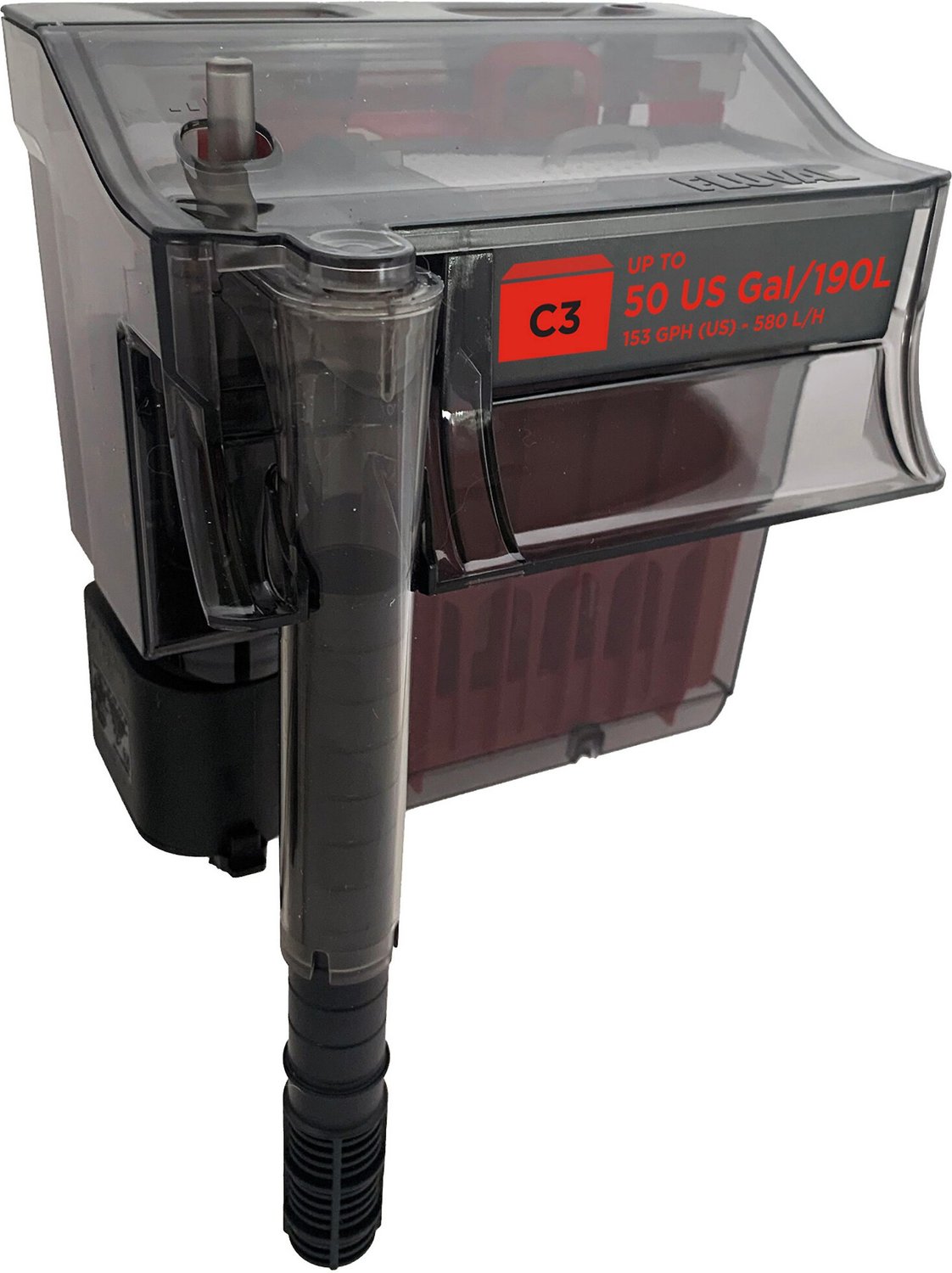
Fluval C Series Power Filter
The Fluval C Series Power Filter is my favorite on this list. Fluval provides excellent quality equipment that doesn’t disappoint.
The C series has multiple chemical and biological filtration methods, providing exceptional cleaning and filtering of debris and toxins.
This clip-on filter fits most tanks and has an adjustable flow rate that uses the patented refiltration system, which is perfect for betta fish.
This is the C3 model suitable for between 20 and 50-gallon aquariums. C1 to C4 sizes are also available through the link below, with a full description of each.
Installing A Filter And Heater
Check both the heater and filter for damaged or exposed wires and electricals before putting them in your tank. They are designed to be placed in water, so they are safe to use.
Heaters should be placed on the back of the tank, and filters should be positioned at one end. Position the filter outlet at the water surface. As water is expelled from the filter, it causes some surface disturbance which helps to oxygenate the tank water.
Set the heater to the correct temperature, 78°F to 80°F (25.5°C – 26.7°C). While your betta tank is being prepared, regularly check the temperature and adjust the heater setting until the correct temperature has been reached.
Most heaters and filters can be positioned quite easily by suction cups. An analog or digital thermometer should be placed away from the heater element so that it only records the water temperature.
How To Setup A Betta Fish Tank Without Filter
Setting up a betta tank without a filter is possible but typically requires more frequent water changes and regular monitoring of water parameters.
The best way to set up a betta tank without a filter is to choose a 20 gallon tank or larger. Small tanks are difficult to maintain as waste builds up too quickly, and oxygen levels rapidly fall.
Large tanks should be heavily planted to provide oxygen for the growth of beneficial bacteria, and a thick layer of substrate will provide a healthy breeding ground for the bacteria.
A healthy environment for bacteria growth increases the level of biological filtration, reducing the need for mechanical filtration.
Biological filtration alone is not as effective in a contained environment such as an aquarium and requires extra effort on your part to reduce the buildup of waste.
If you do have a filterless aquarium, some tips I recommend following are:
- Reduce feeding times and portions to prevent waste building up.
- Regulate the temperature for healthy tank conditions to enhance biological filtration.
- Regularly check for spikes in ammonia and nitrites so you can intervene before they get out of hand.
- Frequent water changes (weekly or bi-weekly) of 15% – 25% to help control waste buildup and ammonia.
- Use biological enhancers to feed the good bacteria and keep their levels high.
Although it’s possible to set up a betta tank without a filter, the added time and effort required to maintain the tank can be easily avoided with the addition of a cheap sponge filter.
Filters For Small Tanks
For a small aquarium, there is a wide range of nano tank or external filters available.
5. Adding Water To Your Betta Tank
Now you are ready to add some water to your betta’s aquarium. Adding water is not just a case of filling it up with tap water, several processes need to take place before the water is ready for new fish.
How do you set up a betta tank water?
Setting up betta tank water is done the same way as for other freshwater fish tanks and is based on several factors.
The steps to prepare your betta tank water are:
- Fill your tank with water – Tap water is fine for betta fish, but location dictates if your tap water is soft or heavy in minerals and other impurities. Treat all tap water with a suitable water conditioner to remove contaminants such as chlorine. Alternatives to tap water are mineral water, spring water, or distilled water.
- Cycle your tank water – New fish tank water can be a harsh environment, either containing too much bacteria or too little bacteria, along with toxic chemicals. Over several weeks your aquarium water develops an ecosystem full of oxygen, bacteria, and necessary chemical compounds, all creating stability and an inhabitable environment for fish.
- Monitor and measure – You will need to closely monitor your water parameters for several weeks. The water will likely become cloudy as bacteria breed. As the cloudiness settles, test that all water parameters fall within acceptable levels before adding your betta fish.
Never add your betta to a tank that hasn’t been correctly prepared, as it can suffer from new tank syndrome, a condition that can cause shock. New tank syndrome causes several health issues and can even be fatal if ignored. I explain about new tank syndrome later in this article.
How Long Should Water Sit Before Adding Betta Fish?
When initially filling a tank with water, it should sit for approximately 4 to 6 weeks while certain chemical and biological processes take place to make it habitable for your betta fish.
When setting up a betta tank, it’s possible to add fish within two weeks, which often helps speed up tank cycling (also known as fish-in cycling), but take extra care to check that water parameters stay within the safe ranges specific to betta fish tank requirements.
You can find a more detailed explanation of tank cycling and water parameters in the next sections.
Cycling A Betta Tank
Cycling a fish tank is a process that allows a tank to produce its own bacteria and become a self-sustaining ecosystem. The good bacteria grow or multiply and help to normalize ammonia, nitrite, and nitrate levels, allowing the water to properly oxygenate.
Cycling a betta tank, just like any aquarium, takes time and is commonly called a fishless cycle. Running a heater and filter during the cycling phase will help to speed up the process as beneficial bacteria grow within the filter media and are distributed into the main water column as it passes through the filter.
Biological enhancers provide an immediate hit of good bacteria, also speeding up the cycling process. A Biological enhancer is a useful way to kick-start the natural process within your aquarium, and they are commonly used for emergency cycling a fish tank.
Ideal Betta Water Parameters
Before it’s safe to add your betta fish, water conditions should sit within the correct parameters, otherwise, you risk your fish’s health, causing them stress.
The nitrogen cycle ensures that toxic ammonia gets eliminated from the tank, with most of it turning to non-toxic nitrates due to the presence of nitrifying bacteria.
During the fishless cycle, the ideal water parameters you should be aiming for are:
| Parameter | Target Value |
|---|---|
| Temperature | 78°-82° Fahrenheit (25.0° – 27.5° Celsius) |
| Water pH level | Between 6.5 and 7 |
| Ammonia levels | Should be 0 mg/L or less |
| Nitrite levels | Should be 0 mg/L or less, but more than 0mg/L is not too serious an issue in a cycled tank |
Use a test kit to check water parameters and keep a thermometer in the tank for easy reference to the current water temperature.
By allowing your tank to sit for long enough before adding your betta fish, all parameters should fall within acceptable levels when testing.
Get to know your tank by testing the water more frequently in the beginning, and you will learn how often water changes are necessary.
6. Choosing Plants And Ornaments
Setting up a betta tank is not just about parameters and equipment, you should try to make it feel like their natural environment. Adding a few plants and ornaments will help bring a natural feel to the tank.
Live plants are best as they aid the natural biological cycle of your tank by providing food and oxygen, but you can also use silk or plastic plants.
The best plants for a betta are live plants that provide good coverage and hiding spots.
A few plants that are recommended are:
- Anubias
- Java Fern
- Hornwort

Some ornaments that I recommend are:
- Wooden Logs – This is a good source of cover for betta fish and also offers shelter to other small invertebrates. It will provide your aquarium with some decoration while providing a natural setting because it has a natural look and feel.
- Marimo Moss Balls – These are another good source of cover for betta fish, but they can also provide shelter to invertebrates that keep your tank clean and healthy, eating excess food particles to help with the biological cycle.
- Plant Pot – A simple plant pot, even a broken one, will provide shady areas for your betta fish to hide.
Make sure new plants and ornaments have been rinsed and are free of chemicals before adding them to your aquarium. Plants can carry diseases, parasites, and other pests that you don’t want to bring into your new aquarium.
Find more examples of ornaments suitable for betta tanks on Amazon or Chewy.
7. How To Put Betta In A New Tank
The final step is adding your betta to their new tank, which can be tricky the first time.
Your new betta fish may become stressed, which you will know if their fins are clamped, and they dart about on top of the water’s surface. Stress is likely to be caused by spending too much time in isolation.
To avoid serious health problems from stress, it is important for your betta to adjust to the new water conditions in their new tank, which is a process called acclimatization.
How To Acclimate Betta Fish
Now that your new tank has been set up correctly, you need to know how to add a betta fish to a new tank. Acclimatization is important, and there are a few steps to follow.
Step 1. Add some water from the newly set up tank into the bag or container with your new betta fish. This will help them gradually adjust to the different water types and temperatures.
Step 2. After around 10-15 minutes, take the container or bag with your betta fish and float it in its new tank so that the water temperature in the container slowly adjusts and your betta can see their new surroundings before being released.
Step 3. Put some food into their new tank to give them some focus and let them know their new environment is one where they can relax.
Step 4. Release your betta gently by gently tipping their container or netting them with your hands behind their head and slowly releasing them.
Your new betta should now be well-acclimatized to its new tank, and you shouldn’t witness any problems.
New Tank Syndrome
Once in the new tank, there is a possibility that your betta will suffer “New Tank Syndrome,” a condition where your betta won’t eat, has clamped fins, darts about the tank, or hides a lot.
Although these behaviors are generally caused by the stress of a new environment, the actual cause of new tank syndrome is a tank that has not been correctly cycled and is still not ready for fish.
When setting up a new tank, it is important to take the time and do everything right. Water needs to be tested for correct parameters and oxygenation.
New tank syndrome is unlikely if you have followed my steps, so any odd behaviors are most likely be caused by stress, especially if they have been in a confined space for an extended period of time.
Provided the stress is not caused by poor water conditions, your betta should be fine in a few days, and they will get used to their new home.
Enjoy Your New Betta Tank
Well done for setting up your new betta tank. Now that you have done it once, it will be much easier the next time. The steps involved are similar for setting up any new freshwater aquarium except for recommended substrates, plants, and ornaments. Some fish also prefer different water parameters than betta fish, so do the required research and tweak as necessary.
Hopefully, you will enjoy your new betta fish and won’t have too many problems along the way. Just feed your betta correctly with a mixture of frozen foods and live food, avoid overfeeding, and give them a balanced diet. Feeding with live foods is also recommended from time to time.


